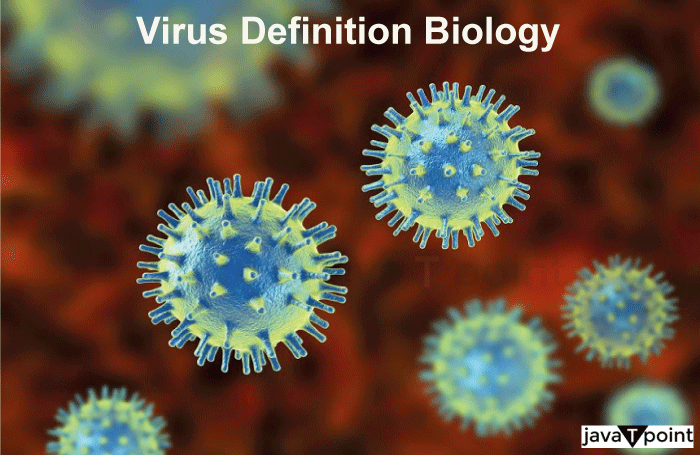Virus Definition BiologyViruses are microscopic, non-cellular infectious organisms that can only reproduce within a host cell. The name is derived from a Latin word that means "slimy liquid" or "poison." The virus cannot replicate outside the host cell because it lacks the necessary biological components. 
Viruses are extremely small, with sizes between 30 and 50 nm. A protective protein layer is a capsid surrounding viruses, which do not typically have cells or a cell wall. Virus ClassificationViruses are categorized based on their shape, chemical structure, and replication method. 1. Host Range-Based ClassificationThere are four main types of viruses, depending on the host:
This virus spreads disease by infecting the cells of animals, including humans. Examples of animal viruses are the influenza virus, herpes virus, rabies virus, poliovirus, mumps virus, etc.
Viruses that harm plants are referred to as plant viruses. Plant viruses are tiny infectious particles with a protein shell and a nucleic acid core. Plant viruses cannot replicate without a host. The potato virus, beetroot yellow and turnip yellow viruses, cauliflower mosaic virus, etc., are examples of plant viruses.
The term "bacteriophage" refers to the virus that attacks bacterial cells. Bacteriophages come in many forms, including DNA viruses, MV-11, RNA viruses, etc.
An insect virus is a virus that affects insects. Insect viruses are commonly referred to as the viral pathogen of insects. These viruses are thought of as effective biocontrol agents in agriculture. 2. Classification Based on Mode of Transmission
Viruses spread by the respiratory route. For example, swine flu and rhinovirus.
The virus spreads via infected water or food. For example, rotavirus, poliovirus, and hepatitis virus.
The virus is spread by sexual activity with an infected individual. For example, retroviruses, human papillomaviruses, etc.
Infections that are spread by blood transfusions are known as transfusion-transmitted infections. For example, HIV, the Hepatitis B virus, etc.
The virus spread via animal bites from infected animals. For example, the rabies virus, the alphavirus, the flavivirus, the ebola virus, etc. 3. Structure-Based Classification
4. Classification of Viruses Based on the Characteristics of Replication and the Location of Replication
5. Classification Based on Nucleic Acid Content1. RNA Virus The genetic substance of an RNA virus is RNA. The common cold, influenza, SARS, MERS, Covid-19, hepatitis C, hepatitis E, Ebola viral disease, rabies, polio, and mumps are serious diseases caused by RNA viruses. Types of RNA virus
2. DNA Virus This particular virus has DNA as its genetic material. Herpes, smallpox, hepatitis B, adenoviruses, and warts are some examples of DNA viruses. Types of DNA virus
Economic Significance of Virus
Characteristics of Viruses1. Non-living Small infectious agents called viruses are also referred to as pathogens. They are not living things and will only grow when they come in contact with living cells. Most of the cellular organelles seen in other organisms are not present in viruses because they are not formed of cells. They require an outside force to survive, such as host animals or plants that provide them nutrition when no oxygen is available. 2. Size and shape Viruses can be found in various sizes and shapes, ranging from basic spherical particles to more intricate structures. The proteins that make up a virus's capsid describe its shape. The capsid is made up of multiple capsomeres that are organized into a particular pattern. 3. Virus structure Viruses are tiny infectious particles that can only replicate inside the cells of other species. A virus is made up of the following:
4. Reproduction Viruses replicate using the lytic cycle and the lysogenic cycle. All viruses cannot reproduce on their own. They require living hosts like the human body, plants, or animals. FAQ on Virus1. Defined virus in simple words. Answer: A virus is an infectious, non-cellular organism formed of genetic material and protein that can only enter and replicate inside the living cells of bacteria, plants, and animals. 2. How do viruses enter inside of the human body? Answer: Viruses typically enter your body from your mucous membranes. These include your mouth, nose, eyes, penis, vagina, and anus. 3. How do viruses function? Answer: Viruses go through several processes to infect cells and reproduce. The several processes are:
4. List out characteristics of viruses. Answer:
5. What exactly are retroviruses? Answer: It is a particular kind of RNA virus that attaches its genome to the host cell's DNA before infecting and altering the host cell's genome. In this instance, RNA viruses utilize their RNA template to generate DNA. It is a reverse of the standard transcription procedure; that's why it is referred to as Retroviruses, for, e.g., HIV. 6. What are a virus's habitats? Answer: Phage refers to viruses that infect prokaryotic organisms. The phage impacts several species, such as soil, meats, fermented vegetables, animal intestines, and marine organisms. 7. Difference Between Viruses & Bacteria. Answer:
8. List out few viral diseases. Answer:
9. What is a virus' main objective? Answer: The main goal is to introduce its genome into a host cell so that it can be generated (via transcription and translation). 10. Differentiate RNA and DNA virus. Answer:
Next TopicWeaning Definition
|
 For Videos Join Our Youtube Channel: Join Now
For Videos Join Our Youtube Channel: Join Now
Feedback
- Send your Feedback to [email protected]
Help Others, Please Share










